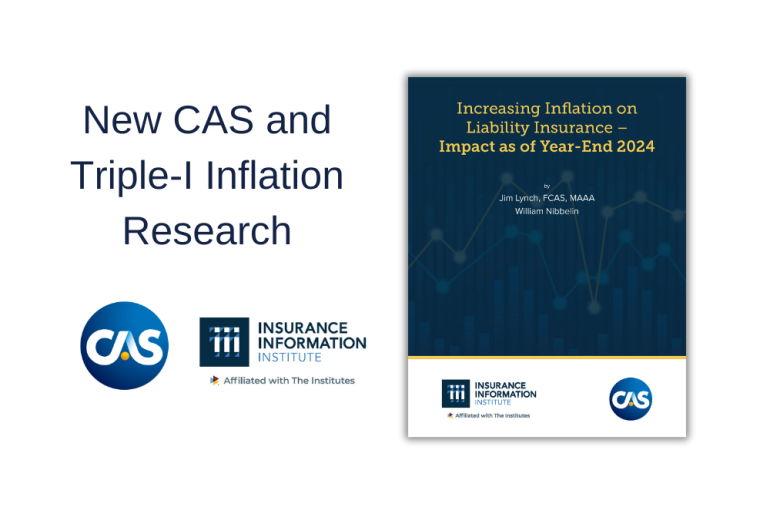New CAS and Triple-I Analysis Quantifies Impact of Legal System Abuse on Liability Insurance Losses

A new analysis by the Casualty Actuarial Society (CAS) and the Insurance Information Institute (Triple-I) finds that legal system abuse (LSA) and related litigation trends contributed to $231.6 billion to $281.2 billion found in increased liability insurance losses over the past decade, a surge that far exceeds what can be explained by economic inflation alone.
The report, Increasing Inflation on Liability Insurance – Impact as of Year-End 2024, finds that rising jury awards, litigation financing, and evolving legal dynamics have driven higher claims costs and defense expenses for Personal Auto, Commercial Auto, Other Liability – Occurrence, and Product Liability – Occurrence.
“This analysis illustrates that the severe spikes in liability insurance claims losses go well beyond normal economic inflation,” said Sean Kevelighan, CEO of Triple-I. “Legal system abuse, manifested through excessive verdicts and litigation behaviors, has fueled a structural rise in claim costs that continues to increase costs for insurers and policyholders alike.”
Key Findings
- Personal Auto Liability: LSA and inflation increased losses and Defense and Cost Containment (DCC) by $91.6 billion–$102.3 billion, or 8.7%–9.7% of booked losses.
- Commercial Auto Liability: $52.0 billion–$70.8 billion, or 22.6%–30.8% of booked losses.
- Other Liability – Occurrence: $83.4 billion–$103.3 billion, or 27.4%–34.0% of booked losses.
- Product Liability – Occurrence: $4.6 billion–$4.8 billion, or 27.1%–28.0% of losses and DCC.
- Total: $231.6 billion - $281.2 billion
Severity, Not Frequency, Drives the Escalation
Across all lines, claim severity, not claim frequency, is driving loss increases. While the number of claims has generally declined, the average cost per claim has soared, far exceeding overall economic inflation as measured by the Consumer Price Index (CPI-U).
Loss development factors (LDFs), actuarial measures of how claim costs evolve, have generally increased since 2008, reflecting the sustained impact of legal system abuse, from litigation financing and attorney involvement to larger jury verdicts and higher settlement values.
“The data clearly show that insurance loss inflation has its own unique drivers,” said James Lynch, FCAS, MAAA, and co-author of the study with Triple-I’s senior actuary William Nibbelin. “While general economic inflation is an important factor, legal trends, ranging from litigation financing to larger jury verdicts, have amplified costs well beyond what the CPI-U would suggest. Expanding this analysis to broader General Liability lines will allow us to quantify inflationary pressures across even more of the insurance landscape, especially given what we’ve observed in civil case trends.”
Legal System Abuse and Civil Case Trends
Earlier research by Triple-I and CAS identified social inflation—rising claim costs tied to litigation behavior and outsized jury awards—as a key contributor to LSA.
A separate Triple-I report on civil case filings estimates that excess value extracted through increased motor vehicle tort lawsuits (2014–2023) totaled $42.8 billion, underscoring how litigation dynamics directly fuel insured losses. While the datasets differ, the civil case evidence supports the conclusion that roughly one-third of the “increasing inflation” in auto liability losses stems from legal system abuse.
“While consumer price inflation peaked in 2022, our data show that loss inflation in liability insurance lines remains structurally higher than before,” Lynch added. “This reflects the combined effects of economic conditions, changing legal dynamics, and higher settlement values.”
Broader Implications
Inflationary losses, driven largely by LSA and social inflation, translate directly into higher premiums and greater capital strain for insurers. The report underscores that even as general inflation moderates, liability loss costs remain persistently elevated.
“This isn’t just about prices rising in the economy, it’s about the cost of our legal system escalating beyond sustainable levels,” Kevelighan said. “Recognizing and addressing legal system abuse is essential to managing costs and protecting consumers.”
About the Study
This latest analysis builds upon prior work by the Insurance Information Institute, usually in conjunction with the Casualty Actuarial Society (CAS), using Schedule P Annual Statement data submitted to the National Association of Insurance Commissioners (NAIC). Over the past five years, Triple-I/CAS have conducted a series of studies using actuarial techniques on this data to detect and analyze inflation in liability lines of business. Earlier papers focused on identifying “excessive inflation in claims,” widely known among insurers as social inflation. The current report applies actuarial methods to evaluate loss development factors, frequency, and severity trends normalized by Gross Domestic Product (GDP) over time, building on this foundational research.
Previous CAS/Triple-I Studies include:
Increasing Inflation on Auto Liability Insurance – Impact as of Year-end 2023 (2024)
Social Inflation and Loss Development — An Update (2023)
Social Inflation and Loss Development (2022)
